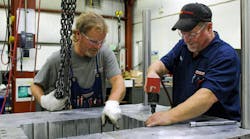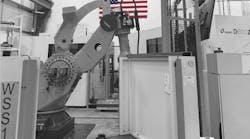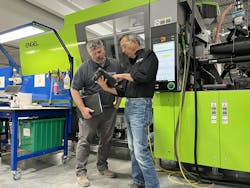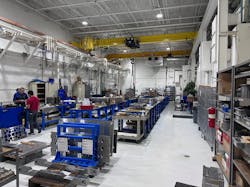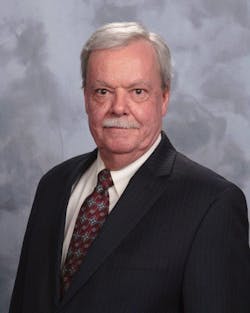What you'll learn:
- Tariffs have disrupted supply chains, driven up costs for raw materials and imported equipment, and created uncertainty for mold makers, but they’ve also opened reshoring opportunities.
- A shrinking and aging workforce is limiting growth. Companies are investing in training programs, but the loss of expertise remains a long-term hurdle.
- U.S. shops can’t always compete on price with overseas suppliers, but buyers are discovering they offer better quality, faster turnaround, closer collaboration and better IP protection.
- Mold shops are expanding services, consolidating operations and embracing automation and smart manufacturing.
By Karen Hanna
Mold making rarely takes a straight-ahead path. Lately, amid a flurry of tariff announcements and posturing over international trade conditions, it’s an even bumpier experience.
John Berg, director of marketing, and Greg Gierach, VP of sales, wrote in a joint statement to Plastics Machinery & Manufacturing, from their perspective working at Menomonee Falls, Wis., injection mold making shop Dynamic Tool Corp.: “It is rare to have extended consistency of work in the mold making industry. Monthly revenues of a tool shop, when bar-charted, often resemble a roller coaster.”
For mold makers, a few issues outside the shop command prominence in discussions about the ride: tariffs, overall costs and labor availability. Efforts to grow, reshore and win business will depend on how they manage.
Riding the ups and downs
While some manufacturers have decried a chaotic rollout of tariffs, with voluminous definitions and ever-changing rates, others have hailed the goal to make American products more cost-competitive. Mold makers reported they’re looking for ways to seize new opportunities.
In December, as business owners looked ahead to changes promised by then-President-elect Trump, Decatur Mold Tool & Engineering Inc. was readying for instability. In a blog post, the North Vernon, Ind., shop boasted, “Decatur Mold is well-positioned to help reduce your uncertainty and lighten your workload in these uncertain times.”
“Our margins are already quite low, and we just don’t have a lot of room to absorb. We’re trying to offset all of these additional costs, including tariffs,” said Rhonda Lustenberger, majority owner and president of the shop, which in recent years has embarked on a mission to create efficiencies, including with investments in automation.
“Uncertain” has proved an apt word.
“The impacts of a stressed economy and the uncertainty of policy changes in the U.S. have caused a pause in sourcing strategies. The purchasing / capitalization strategies of U.S. businesses have altered in the past year,” Berg and Gierach said.
StackTeck’s Vince Travaglini said early on, business seemed handcuffed by tariff worries. But by late May, as he prepared to retire as the CEO of the Brampton, Ontario, shop, business was humming. He was ready to move onto his next chapter; so were StackTeck and its customers. “Our customer base said, ‘business as usual.’ What are we going to do? Sit here and wait? I mean, we got four years of this,” he said.
But tariffs generate both problems and solutions. While tariffs on molds and tooling from abroad could help U.S.-based builders, for example, duties on raw materials cut into already-tight margins. For companies looking to exploit new opportunities, there’s also the conundrum of investing in new equipment — if it comes from abroad, it probably costs extra.
Lustenberger said the cost of metal worries her.
“It's not been a huge topic amongst our customers. I am very concerned, because I think a lot of people are discounting the new pricing power that domestic steel and aluminum manufacturers will have because of the tariffs on [outside] suppliers, and that our costs will go up; whether we're using domestic steel or or foreign steel, we're still going to be impacted," she said. “And I don't think that's being considered significantly by our customers and/or our suppliers. It is a risk for the future.”
All those possible increases eventually flow to the end user, according to Berg and Gierach.
“It’s no surprise that no one wants to pay them. The cost of tariffs will end up on the desk of the OEM / brand owner and will ultimately be passed on to the consumer / end user. Tariffs have had a trickle-down effect — impacting everything from raw materials to purchased components, packaging and transportation,” they said.
In their statement, they captured the tariffs’ ups and downs.
“Tariffs have already affected the supply chain and have slowed product launch plans. Certainly, this holds true for significant equipment investments. The current climate has put a pause on program timelines in some cases. Conversely, those pauses have facilitated other OEMs time to become opportunistic, invest and gain market share in categories they may have missed in the past.”
Price is right
Fresh on the heels of the pandemic era’s unprecedented supply chain challenges, tariffs on foreign-made goods underscore a dawning reality for some prospective mold buyers: Price ain’t everything.
The turmoil of the last few years has broken through a feeling of inertia, making domestic production look more attractive, according to Kent Savage, the founder and executive chairman of the Velocity Group.
“Manufacturing is a rhythm and it's a cycle, and when things are going well, there's a lot of temptation, don't fix what ain't broke. But now it's broke, and looking at it, they're saying, ‘Hey, this makes a lot of sense.’ ”
For his company, which provides a full array of services, including molding and mold making, along with others, that means prospective customers are now willing to consider factors other than price.
The costs and benefits of a job aren’t labor alone — there are quality and supply chain considerations, as well.
“I’m not going to say that we can make a tool in the U.S. for the same price or even a lesser price than what can be made offshore, but we can make a better tool, faster, and one that may be more productive,” Savage said, “... With that collaboration, oftentimes, we can find more efficient ways, and if we can reduce cycle times, if we can get more productivity out of the tool, then it becomes actually much more productive; so, the cost of the tool and then its productivity over its life, all have to be looked at together.”
As Berg and Gierach said, “Defining the scope of work and comparing proposals of ‘A’ vs ‘B’ are more important now than ever.”
To help provide a more complete picture, the Reshoring Initiative, a nonprofit founded in 2010 by Harry Moser, provides a Total Cost of Ownership Estimator, which helps quantify the benefits of domestically produced goods.
According to the initiative’s 2024 report, 244,000 jobs were reshored last year.
At least one of those jobs landed at American Tool & Mold (ATM) Inc., a Clearwater, Fla., shop that builds injection tooling and molds parts, according to principal engineer Victor Cohen.
Of the shop’s two main activities, the stakes are especially high on the mold building side. Tariffs have upped the ante.
“The challenges are mostly being competitive on the tool building,” Cohen said. “The tariffs have brought in so far one job because the customer didn’t want to be burdened with sending it to an overseas or non-U.S. vendor, so they chose us for that; otherwise, they probably would have gone back to them, because they are cheaper. We’re better, and everybody knows it, but not everybody’s willing to pay for it, but we can’t drop our margins that low.”
The Reshoring Initiative’s report cites other advantages: avoiding geopolitical risks or the presumed costs of pending tariffs, along with a desire to shorten supply chains.
In its blog post, Decatur Mold identified additional benefits: the ability to support American jobs, fast turnaround and reliability. It said, “If your current operations depend significantly on molds manufactured abroad, the proposed tariffs could disrupt your cost structure and supply chain. Decatur Mold, with its domestic production capabilities, stands ready to offer a compelling alternative.”
In Byesville, Ohio, the Velocity Group is seeing work previously performed in Mexico, India and Vietnam.
Without the constraints of extreme time-zone differences or language and cultural barriers, working together with U.S.-based customers just makes sense, Savage said.
“One of the big benefits, I believe, is the close collaboration that can happen if you're working in a domestic environment,” he said.
Also, he pointed out advantages related to intellectual property (IP). While customers might worry their IP isn’t safe with some overseas manufacturers, the possible theft of sensitive ideas or inventions isn’t the only concern that should trouble them, according to Savage.
In one case, a customer approached the Velocity Group with a sophisticated sensor used in devices for railroad-safety applications.
“They worked with another supplier for two years, and they couldn’t get it right, and we were able to solve that, and the real cost to that company, there’s two years of the patent clock off, which was huge,” Savage said.
While he’s seeing a movement toward reshoring, he conceded, “it’s still a very unsettled environment."
“It’s just the early days, and I don’t believe that even when the tariffs are resolved at some point or later, that we’ll know what the playing field is, and it won’t go back to like it was. It won’t go back to saying the lowest-cost tool, the lowest-cost producer, is the way to go.”
Labor pains
An increase in work could bring its own issues, as tool makers fight to lure prospective employees.
Like many mold makers, Emilia Giannakopoulos, CEO of ATM, which employs about 200 people, said her company is active in trying to train workers to compensate for shortages in the labor pool.
“We’re involved in growing that pipeline because, in a way, we’re almost a dying industry. We’re so labor-intensive, the labor, the skill set, the craftsmanship. It’s an art, and we pride ourselves in training and teaching and creating that next generation,” she said.
“It’s going to take a long time to get the workforce back. I think we waited too long. The offshoring happened during the ’80s and ’90s, and now to bring that all back, we’ve lost the manufacturing expertise, and the people retired, and they’re gone, so that we don’t have the people that could be training them,” he said.
It’s a dilemma for both Guill Tool and its customers. Recently, one customer came to the company with a request a little outside the tool maker’s normal services.
“They make window frames. ... The guy wanted me to quote that, and it’s really difficult for me to make,” Baldock said. “I said, ‘Typically, the window frame suppliers would manufacture their own dies because it’s an iterative process; you come up with a design, and then it has to be re-machined maybe many times before you finally get an acceptable product.’ ... He responded by saying, ‘I’ve got a whole room full of CNC machines. I just don’t have anybody to run them.’ ”
Building for the future
To prepare for the future, tool makers expressed plans to grow their own workforce and pounce on new opportunities.
The July issue of the Perc Report, an analysis released by the Plastics Industry Association and its chief economist, Perc Pineda, reveals volatity. In April, U.S. exports of molds for plastics rose 10.7 percent from the previous month but were down 21.9 percent, compared with April 2024. Exports to Mexico totaled $93.8 million year to date through April. Mold imports declined 18.1 percent in April from March, but were 13.2 percent higher over April 2024.
Savage is one tool maker who’s bullish on the future.
A serial entrepreneur who’s cobbled together a full-service array of shops in rural Ohio, Savage said he initially worried about finding workers.
But the Velocity Group is growing and moving ahead with plans to consolidate services under one roof in Guernsey County, Ohio, which in 2020 had a population of around 38,000. It’s roughly 80 miles from Columbus and 100 miles from Pittsburgh; the county seat is Cambridge, a city of just around 10,000.
“I bought that company there in Cambridge, 12, 13 years ago, and I was concerned about the question: Could we attract good people there?” Savage said. “But most of the folks live within 30, 45 minutes, and we’ve got professionals at the highest engineering level of management, and we find a lot of our production workers are semi-skilled. … Probably the skilled trades are the most difficult. ... We let people grow to their own levels and if they have aspirations, we don’t have any preconceived notions about what pedigree they have to have. One gentleman that started pushing a broom, he became a mold maker.”
At StackTeck in May, the retiring Travaglini and fellow executive Mike Gould, who succeeded him, also were contemplating career moves.
A key strategy for the company involves building out its non-mold making activities, including a new spinoff business segment focused on automation, to help customers address their own workforce challenges.
Both men echoed a message delivered by other professionals in the sector: Overall, business is good.
“There possibly was a bit of a hesitation back in February when there was more uncertainty, but most people digested that and looked beyond to say, ‘Well, we still need to operate. We still need to do things as we do today,’ ” Gould said. “Maybe there’s a long-term impact down the road two, three, four years. It takes time for these things to settle in. But the immediate opportunity is, with respect to large brand owners, where we have major programs with them, they’re doing major product launches, which require multiple tools in many cases, and we’re uniquely positioned with some very unique technologies."
Whatever the bumps ahead, he and Gould expressed optimism that StackTeck will be ready. Like other companies in the sector, it’s gearing up for the road ahead.
“There’s definitely an opportunity to grow within the existing market space,” Gould said.
Contact:
Guill Tool & Engineering Co., Inc., West Warwick, R.I., 401-828-7600, https://guill.com
StackTeck Systems, Brampton, Ontario, 888-700-8555, https://stackteck.com
About the Author
Karen Hanna
Senior Staff Reporter
Senior Staff Reporter Karen Hanna covers injection molding, molds and tooling, processors, workforce and other topics, and writes features including In Other Words and Problem Solved for Plastics Machinery & Manufacturing, Plastics Recycling and The Journal of Blow Molding. She has more than 15 years of experience in daily and magazine journalism.

